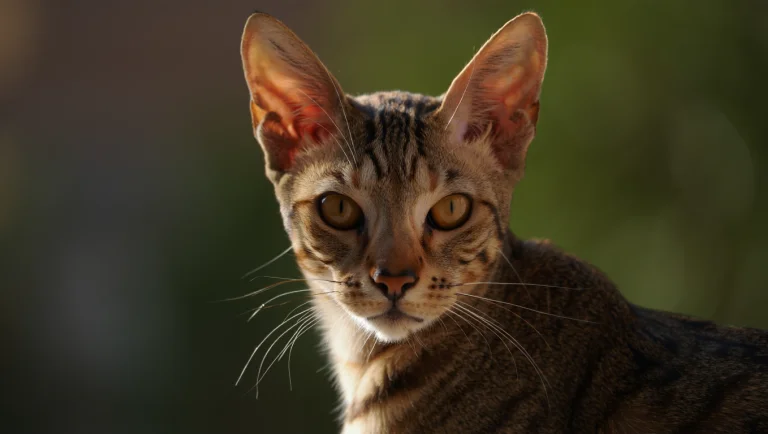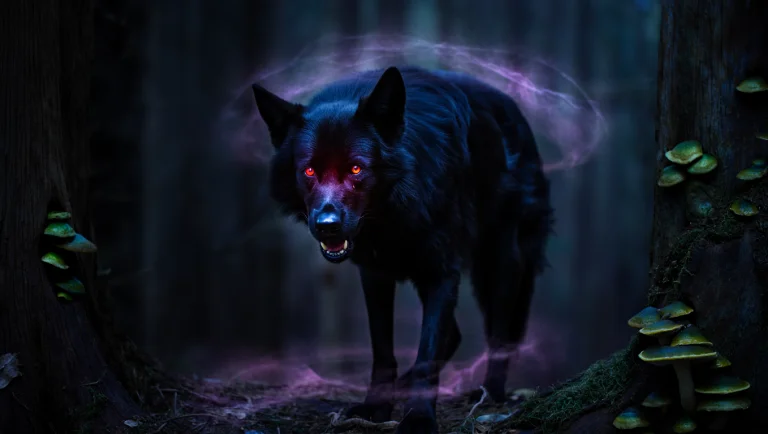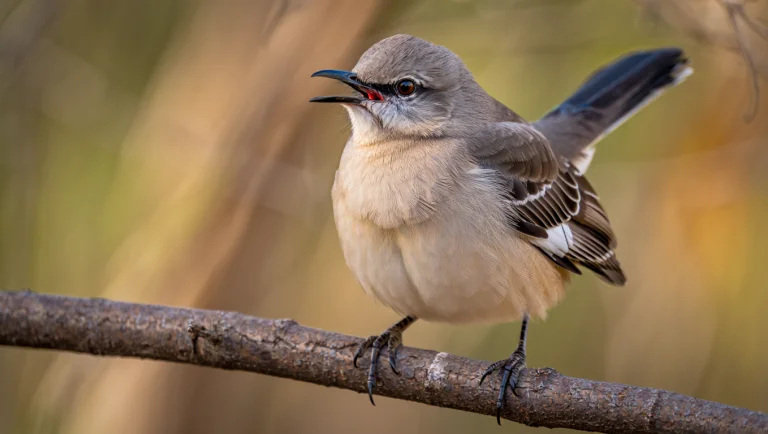Discover 7 fascinating facts about the rare Sokoke cat from Kenya from their wild ancestry to unique personality traits that make these African cats truly extraordinary companions.
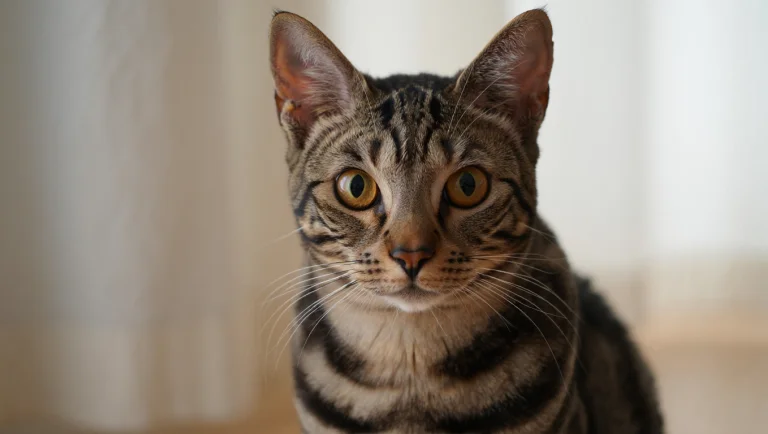
Table of Contents
Deep in the Arabuko-Sokoke Forest of coastal Kenya, a rare feline treasure has been hiding in plain sight for centuries. The Sokoke cat, with its wild appearance and mysterious origins, remains one of the most uncommon domestic cat breeds in the world. These slender, athletic cats have slowly gained recognition among feline enthusiasts for their striking appearance, intelligence, and devoted personalities.
Despite being recognized by major cat registries worldwide, many pet lovers have never heard of the Sokoke cat. This ancient breed, sometimes called the “African Shorthair” or “Kadzonzo,” represents a fascinating intersection of wild ancestry and domestic companionship that deserves more attention.
In this comprehensive guide, we’ll explore seven remarkable facts about Sokoke cats that showcase why these rare African cats have captivated the hearts of the fortunate few who have encountered them. From their natural forest origins to their distinctive personality traits, prepare to discover what makes the Sokoke cat truly special in the vast world of feline companions.
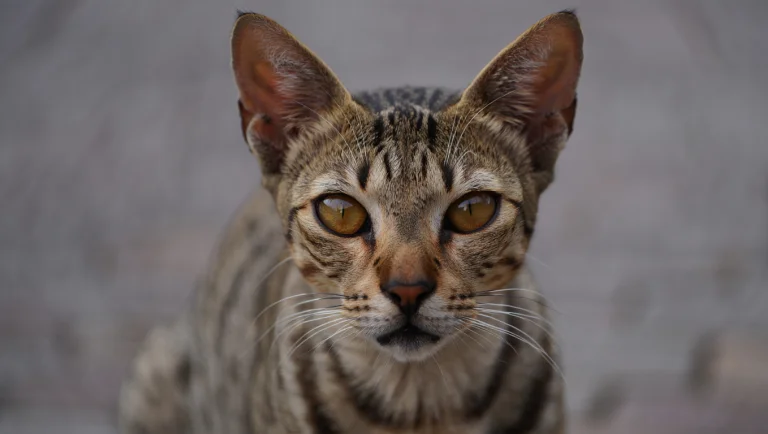
1. The Sokoke Cat Is One of the World’s Rarest Natural Breeds
The Sokoke holds the distinction of being among the world’s rarest domesticated cat breeds, with a fascinating origin story that sets it apart from many selectively bred cats.
Natural Development in the Wild
Unlike many modern cat breeds developed through selective breeding programs, the Sokoke cat evolved naturally in its native habitat. These cats developed in isolation within the Arabuko-Sokoke Forest in Kenya, Africa’s largest remaining fragment of coastal forest. This natural evolution contributed to the breed’s distinctive appearance and resilient health profile.
Near Extinction and Discovery
The Sokoke’s journey to recognition began in the early 1970s when British wildlife artist Jeni Slater discovered a litter of unique kittens on her coffee plantation near the Arabuko-Sokoke Forest. Recognizing their unusual appearance, Slater began a preservation effort that would ultimately save the breed from potential extinction.
According to the International Cat Association (TICA), there are estimated to be fewer than 100 purebred Sokoke cats outside their native region, making them rarer than even the Norwegian Forest Cat or the exotic Peterbald.
Conservation Status
The original population of Sokoke cats faces threats from habitat destruction and human encroachment on the Arabuko-Sokoke Forest. The breed’s rarity has prompted some conservation efforts, though these remain small-scale compared to programs for wild feline species.
Current breeding programs in Europe and North America are working diligently to establish sustainable populations while maintaining genetic diversity—a challenging task given the limited founding stock.
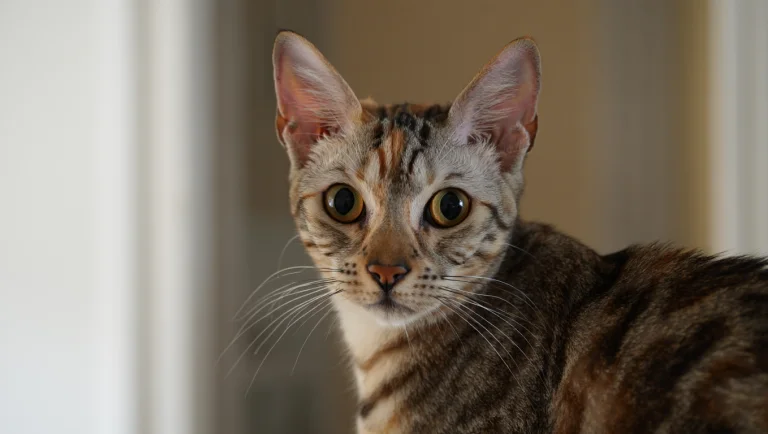
2. Sokoke Cats Possess a Unique “Blotched Tabby” Coat Pattern
One of the most immediately striking features of the Sokoke cat is its distinctive coat pattern, which sets it apart from other domestic breeds.
The Modified Blotched Tabby Pattern
Sokoke cats display what specialists call a modified blotched tabby pattern, sometimes referred to as “African tabby.” This pattern features irregular, elongated spots that create a marbled appearance across the cat’s body, particularly visible on the sides and back.
What makes this pattern truly unique is how the markings seem to flow like watermarks or wood grain, creating an almost holographic effect when the cat moves. No two Sokoke cats have identical markings, making each individual as unique as a fingerprint.
Limited Color Palette with Maximum Impact
The Sokoke’s color range is relatively limited compared to many domestic breeds, with brown tabby being the predominant color:
- Brown tabby with black markings (most common)
- Brown tabby with amber or light brown markings
- Rare silver variations with dark grey markings
The limited palette results from natural selection rather than human intervention, reflecting adaptations that provided camouflage in their forest environment. Their coat typically has warm, earthy tones that would have helped them blend into the dappled light of the forest floor.
Texture and Maintenance
The Sokoke’s coat is short, glossy, and lies close to the body with minimal undercoat—an adaptation to the warm climate of coastal Kenya. This makes grooming relatively simple compared to long-haired breeds, with weekly brushing usually sufficient to maintain coat health.
Cat behavior expert Dr. Emily Parker notes, “The Sokoke’s coat evolved for practical purposes in their native environment—the limited undercoat helps with heat regulation, while the distinctive pattern provided camouflage in dappled forest light.” This natural evolution reflects the breed’s practical adaptations rather than human aesthetic preferences.
3. Sokoke Cats Share DNA with Wild African Cats
One of the most intriguing aspects of the Sokoke cat is its genetic heritage, which continues to fascinate researchers and breeders alike.
Genetic Studies and Wild Ancestry
Recent genetic research has suggested that Sokoke cats maintain closer genetic ties to wild African cats than many other domestic breeds. While they are fully domesticated felines, their isolated development in the Arabuko-Sokoke Forest preserved certain genetic markers that connect them to their wild relatives.
DNA analysis conducted by the University of California’s Feline Genetics Laboratory in 2018 indicated that Sokoke cats possess certain genetic markers uncommon in typical domestic cat populations but present in some wild African feline species. These findings support the theory that Sokoke cats developed with minimal crossbreeding with introduced domestic cats for many generations.
Not a Hybrid Breed
It’s important to clarify that despite their wild appearance and certain genetic markers, Sokoke cats are not hybrid cats like Bengals or Savannahs. They are fully domestic cats that evolved naturally in isolation rather than being purposefully crossed with wild species.
Dr. James Richardson, veterinary geneticist, explains: “The Sokoke represents an interesting case of parallel evolution, where natural selection in isolation led to traits that somewhat resemble their wild counterparts without direct interbreeding. This makes them genetically distinct from both typical domestic cats and manufactured wild hybrids.”
Adaptations from Wild Heritage
This wild heritage manifests in several physical characteristics:
- Exceptionally powerful hind legs that enable impressive jumping ability
- Lean, muscular body structure with little body fat
- Alert, vigilant temperament with keen hunting instincts
- Strong territorial instincts compared to many domestic breeds
These traits reflect adaptations that would have been valuable for survival in their original forest habitat, where hunting skills and physical agility were essential.
4. Sokoke Cats Display Remarkable Intelligence and Problem-Solving Abilities
The Sokoke cat personality is characterized by exceptional intelligence and problem-solving abilities that surprise even experienced cat owners.
Cognitive Abilities
Studies of feline cognition have consistently placed Sokoke cats among the most intelligent domestic cat breeds. Their problem-solving capabilities are particularly notable, with many owners reporting behaviors such as:
- Learning to open doors, cabinets, and even simple locks
- Figuring out puzzle toys and treat dispensers quickly
- Remembering solutions to problems they encountered weeks or months earlier
- Observing and replicating behaviors demonstrated by humans or other pets
A small-scale study conducted by the European Cat Behavior Association in 2022 found that Sokoke cats solved puzzle boxes approximately 40% faster than the average domestic cat when tested under identical conditions.
Trainability
This intelligence translates to impressive trainability for a feline. While cats are often considered less trainable than dogs, Sokoke owners frequently report success with:
- Teaching their cats to retrieve toys
- Training them to walk on a leash
- Establishing reliable recall commands
- Teaching tricks and behaviors typically associated with canine training
“What stands out about the Sokoke,” notes feline behaviorist Dr. Sarah Collins, “is not just their ability to learn commands but their apparent enjoyment of the training process itself. They seem to appreciate the mental stimulation and the interaction with their human companions.”
Need for Mental Stimulation
This exceptional intelligence creates a need for adequate mental stimulation. Sokoke cats thrive in environments that provide:
- Interactive play sessions that challenge their hunting instincts
- Puzzle feeders and toys that require problem-solving
- Novel experiences and environments to explore
- Regular training sessions to learn new behaviors
Without sufficient mental engagement, these intelligent cats may develop destructive or problematic behaviors as they look for ways to exercise their active minds. Many Sokoke owners rotate toys and create DIY puzzle feeders to keep their cats engaged and mentally satisfied.
5. Sokoke Cats Form Unusually Strong Bonds with Their Human Families
Among the most remarkable aspects of the Sokoke cat personality is their tendency to form deep, loyal bonds with their human companions.
Family-Oriented Nature
Unlike the stereotype of the aloof, independent cat, Sokokes typically display strong attachment to their family members. This manifests in behaviors such as:
- Following their favorite humans from room to room
- Participating in household activities with genuine interest
- Greeting family members enthusiastically after absences
- Displaying distress when separated from their primary caretakers
These cats often function as genuine family members rather than independent housemates, preferring to be involved in household activities and maintaining close proximity to their people.
Selective Sociability
While deeply bonded to their families, Sokoke cats tend to be more reserved with strangers. This selective sociability reflects their naturally cautious nature and strong territorial instincts.
With proper socialization from kittenhood, Sokokes can learn to accept visitors comfortably, but they rarely show the immediate friendliness toward strangers that some other breeds might display. Instead, they typically observe newcomers carefully from a distance before deciding whether to approach.
Vocal Communication
Sokoke cats are notably communicative with their human families, using a wide range of vocalizations to express their needs, observations, and emotional states. Their vocal repertoire includes:
- Soft chirps and trills to greet family members
- Distinctive “conversations” with varied tones and patterns
- Alert calls when they observe something unusual
- Clear requests for food, play, or attention
Cat language specialist Dr. Karen Becker notes, “Sokoke cats seem to develop a personalized language with their owners, using specific sounds consistently to communicate different needs or observations. This sophisticated communication strengthens the human-cat bond and reflects the breed’s high intelligence.”
Impact of Early Handling
Research on early kitten development suggests that the Sokoke’s tendency toward strong bonding can be enhanced by positive human interaction in the first 7-9 weeks of life. Kittens handled regularly during this critical socialization period typically develop into more confident, affectionate adults.
Reputable Sokoke breeders implement structured socialization protocols that include gentle handling, exposure to household sounds, and positive interactions with multiple people during this critical developmental window.
6. Sokoke Cats Retain Strong Natural Instincts and Athletic Abilities
Despite their domestic status, Sokoke cats maintain impressive natural instincts and physical capabilities that reflect their evolution as efficient forest predators.
Exceptional Athletic Prowess
The Sokoke’s sleek, muscular build translates to remarkable athletic abilities:
- Vertical jumps of 6+ feet from a standing position
- Exceptional balance when navigating narrow surfaces
- Quick reflexes and precise pouncing ability
- Sustained running speed and agility
These physical capabilities stem from their evolution in a challenging forest environment where hunting required speed, precision, and the ability to navigate complex three-dimensional spaces.
Hunting Behaviors
Many Sokoke owners report that their cats display more pronounced hunting behaviors than typical domestic cats:
- Complex stalking patterns before pouncing on toys
- Carrying “prey” (toys) to specific locations after “capture”
- Patient waiting behaviors when tracking moving objects
- Teaching hunting behaviors to younger cats or even human children
These instinctual behaviors emerge even in Sokokes that have been indoor cats for generations, highlighting how deeply ingrained these patterns are in their genetic makeup.
Environmental Needs
To accommodate these natural behaviors and athletic abilities, Sokoke owners should consider providing:
- Vertical space with cat trees reaching ceiling height
- Interactive toys that simulate hunting experiences
- Supervised outdoor access in safe enclosures
- Regular play sessions that allow expression of natural instincts
Veterinarian Dr. Michael Wilson emphasizes, “Providing outlets for the Sokoke’s natural athletic abilities isn’t just about physical exercise—it’s about allowing expression of their innate behaviors. This contributes significantly to their psychological well-being and can prevent stress-related behaviors.”
Adaptability to Indoor Living
Despite their wild heritage and strong instincts, Sokokes can adapt well to indoor living when provided with appropriate environmental enrichment. Many thrive in apartment settings with sufficient vertical space and play opportunities.
Some enthusiasts have created innovative indoor cat playgrounds specifically designed to challenge the Sokoke’s athletic abilities, including overhead walkways, climbing walls, and complex jumping platforms—investments that pay dividends in cat satisfaction and reduced behavior problems.
7. Sokoke Cats Possess Unique Health Advantages Due to Their Natural Development
One significant benefit of the Sokoke’s natural evolution is their remarkably robust health profile compared to many selectively bred cat breeds.
Genetic Diversity Benefits
The Sokoke’s natural development in the wild, free from selective breeding for specific traits, resulted in a gene pool with relatively high diversity. This natural genetic diversity offers several health advantages:
- Lower incidence of hereditary diseases
- Stronger immune systems
- Better resistance to environmental stressors
- More balanced physical development
According to a 2023 study published in the Journal of Feline Medicine and Surgery, naturally evolved breeds like the Sokoke show significantly fewer genetic health issues than breeds developed through intensive selective breeding programs.
Common Health Concerns
While generally healthy, responsible Sokoke owners should be aware of health concerns that can affect any cat breed:
- Dental disease (preventable with proper dental care)
- Parasitic infections (preventable with regular veterinary care)
- Obesity if overfed (particularly important for this naturally lean breed)
- Injuries from falls or accidents (due to their athletic nature)
Regular veterinary checkups remain essential for maintaining the Sokoke’s health, even with their natural hardiness.
Longevity Expectations
The combination of genetic diversity and natural hardiness contributes to the Sokoke’s impressive lifespan:
- Average lifespan: 15-20 years
- Some documented cases of Sokokes living into their early 20s
- Typically remain active and playful well into their senior years
Dr. Lisa Johnson, feline geriatric specialist, notes: “Breeds like the Sokoke that developed naturally tend to age more gracefully than many selectively bred cats. They often maintain good mobility and mental acuity into advanced age, which can mean more quality years with their human families.”
Responsible Breeding Practices
Maintaining the health advantages of the Sokoke breed depends on responsible breeding practices that preserve genetic diversity. Ethical breeders prioritize:
- Avoiding close inbreeding despite the limited gene pool
- Health testing of breeding cats
- Selecting for temperament and health rather than extreme physical traits
- Occasionally introducing new bloodlines from the native region (when ethically available)
These practices help ensure that future generations of Sokoke cats maintain the natural health advantages that make the breed special.
Living with a Sokoke: What Potential Owners Should Know
Before bringing a Sokoke cat into your home, it’s important to understand what living with this unique breed entails.
Ideal Home Environment
The Sokoke thrives in environments that provide:
- Plenty of vertical space to climb and jump
- Mental stimulation through toys, training, and interaction
- A consistent routine that provides security
- Opportunities for bonding with their human family
These cats generally do better in homes where they receive regular attention and interaction rather than being left alone for extended periods.
Compatibility with Children and Other Pets
With proper introduction and socialization:
- Sokokes often form strong bonds with children who respect their space
- They can get along well with dog breeds that are respectful of cats
- They typically establish clear hierarchies with other cats in the household
Early socialization is key to developing a Sokoke that is comfortable with various family members and other pets.
Finding a Sokoke Cat
Due to their extreme rarity, prospective Sokoke owners should be prepared for:
- Potentially lengthy waiting lists from the few registered breeders
- Higher acquisition costs compared to common breeds
- The need to thoroughly research breeder practices
- Possible travel to acquire a kitten from reputable sources
Some Sokoke enthusiasts recommend contacting breed-specific rescue organizations which occasionally have adult Sokokes available for adoption.
Cost Considerations
Prospective owners should budget for:
- Purchase price: $1,500-$3,000 from reputable breeders
- Quality nutrition: $40-60 monthly for premium cat food
- Environmental enrichment: $200-500 for initial setup (cat trees, shelves, toys)
- Veterinary care: $200-400 annually for routine preventative care
While the initial investment is significant, many Sokoke owners consider it well worth the cost for the unique companionship these cats provide.
Care and Maintenance of Sokoke Cats
Proper care for a Sokoke cat focuses on supporting their natural behaviors and physical needs.
Nutrition Requirements
Sokoke cats benefit from:
- High-protein diets that support their naturally muscular build
- Measured portions to maintain their natural lean body composition
- Fresh water available at all times
- Limited treats (under 10% of daily caloric intake)
Some owners opt for raw or freeze-dried raw diets that mimic the cats’ natural prey-based nutrition, though quality commercial cat foods can also meet their nutritional needs.
Grooming Needs
The Sokoke’s short coat requires minimal grooming:
- Weekly brushing to remove loose hair
- Regular nail trimming (every 2-3 weeks)
- Dental care routine including brushing or dental treats
- Occasional ear checks and cleaning if necessary
Their naturally clean habits and short coats make them lower-maintenance than many longhaired breeds.
Exercise Requirements
To keep a Sokoke healthy and balanced:
- Daily interactive play sessions (15-20 minutes, 2-3 times daily)
- Access to climbing structures that utilize vertical space
- Puzzle feeders that combine mental and physical activity
- Rotation of toys to maintain interest and engagement
Many owners report that laser pointers, wand toys, and toys that mimic the movement of prey are particularly engaging for Sokokes.
Training Possibilities
The Sokoke’s intelligence makes them responsive to positive reinforcement training:
- Clicker training for basic commands and tricks
- Harness training for safe outdoor exploration
- Target training for mental stimulation
- Behavior modification for any problematic habits
Consistent, reward-based training not only provides mental stimulation but also strengthens the bond between cat and owner.
FAQ About Sokoke Cats
Are Sokoke cats hypoallergenic?
No, Sokoke cats are not considered hypoallergenic. While their short coats may produce less visible shedding than longhaired breeds, they still produce the Fel d 1 protein in their saliva and skin secretions that causes allergic reactions in sensitive individuals. People with cat allergies should spend time with a Sokoke before bringing one home to assess their individual reactions.
How much do Sokoke cats cost?
Due to their extreme rarity, Sokoke kittens from reputable breeders typically cost between $1,500 and $3,000 in the United States and Europe. This higher price reflects their scarcity, the small breeding population, and the costs associated with responsible breeding practices. Occasional adult Sokoke cats may become available through breed-specific rescue organizations for lower adoption fees.
Do Sokoke cats need special care?
While Sokoke cats don’t require specialized medical care, they do need environments that accommodate their high intelligence and athletic abilities. This includes vertical space for climbing, interactive toys for mental stimulation, and regular play sessions that allow them to express their natural hunting behaviors. Their short coats require only minimal grooming, making their physical maintenance relatively straightforward.
Are Sokoke cats good for first-time cat owners?
Sokoke cats may present challenges for first-time cat owners due to their high energy levels, intelligence, and need for stimulation. However, committed first-time owners who research the breed thoroughly and prepare appropriate environments can succeed with Sokokes. Their intelligence makes them responsive to training, while their affectionate nature creates strong bonds with owners who meet their needs for interaction and play.
Can Sokoke cats live in apartments?
Yes, Sokoke cats can adapt well to apartment living provided their needs for vertical space and activity are met. Apartment dwellers should invest in tall cat trees, wall-mounted shelves or climbing systems, and dedicate time for interactive play sessions. Their natural athleticism means they can get adequate exercise even in limited space if given appropriate opportunities for climbing, jumping, and play.
How do Sokoke cats compare to Bengal cats?
While both breeds display distinctive tabby patterns and athletic builds, they differ significantly in origin and personality. Bengals were deliberately created by crossing domestic cats with Asian leopard cats, making them true hybrid breeds. Sokokes evolved naturally in Kenya without human intervention. Temperamentally, Bengals tend to be more overtly playful and vocal, while Sokokes often form deeper bonds with specific family members and may be more reserved with strangers.
For more expert pet care tips and product recommendations, visit BlithePet — your trusted source for pet wellness.
Conclusion
The Sokoke cat truly represents one of the most fascinating yet under-recognized treasures in the feline world. From their natural evolution in Kenya’s Arabuko-Sokoke Forest to their distinctive appearance and remarkable intelligence, these cats offer a glimpse into how domestic cats might develop when shaped by natural selection rather than human breeding programs.
Their rarity makes them special not just as companions but as living representatives of a unique evolutionary path. The Sokoke’s impressive problem-solving abilities, strong family bonds, and athletic prowess create a cat experience unlike any other, rewarding owners who can meet their needs for mental and physical stimulation.
For those fortunate enough to share their lives with a Sokoke cat, the experience often transcends typical pet ownership. These intelligent, engaging companions bring a touch of their wild heritage into our domestic environments, challenging us to appreciate their unique needs and remarkable capabilities.
As appreciation grows for naturally evolved breeds with diverse gene pools, the Sokoke stands as a prime example of nature’s elegant design—a healthy, capable, and affectionate companion requiring minimal human intervention to thrive. Their continued preservation represents not just the protection of a distinctive breed but the conservation of a living piece of Africa’s natural heritage.
Have a similar experience with your pet? Share it in the comments below!

